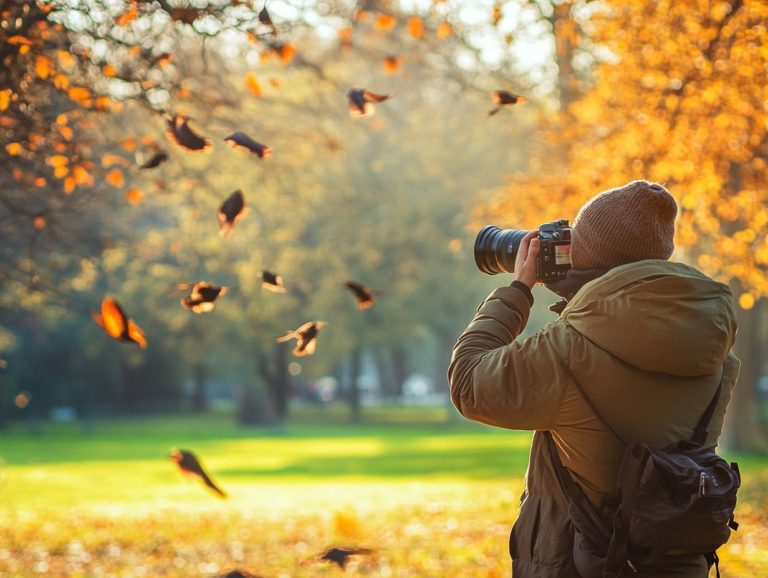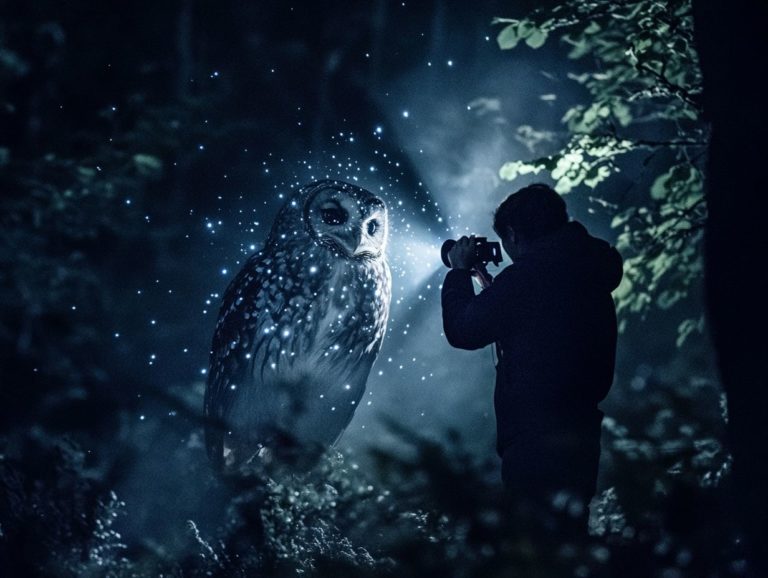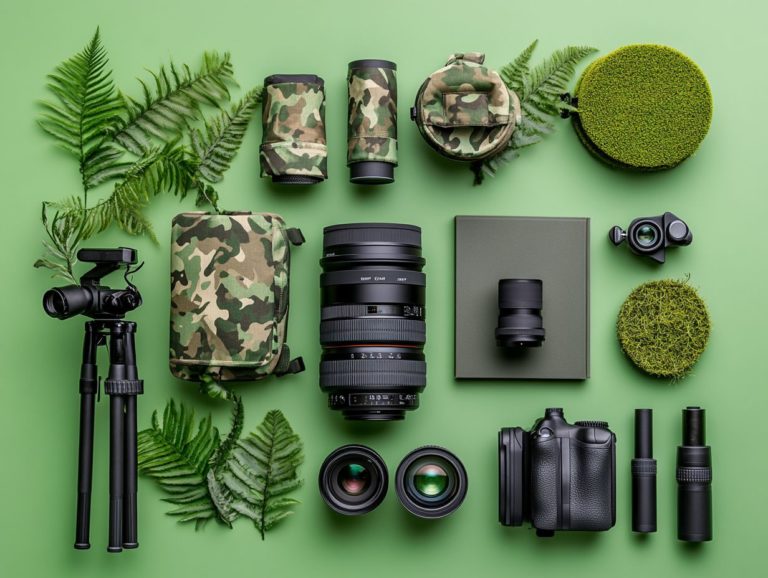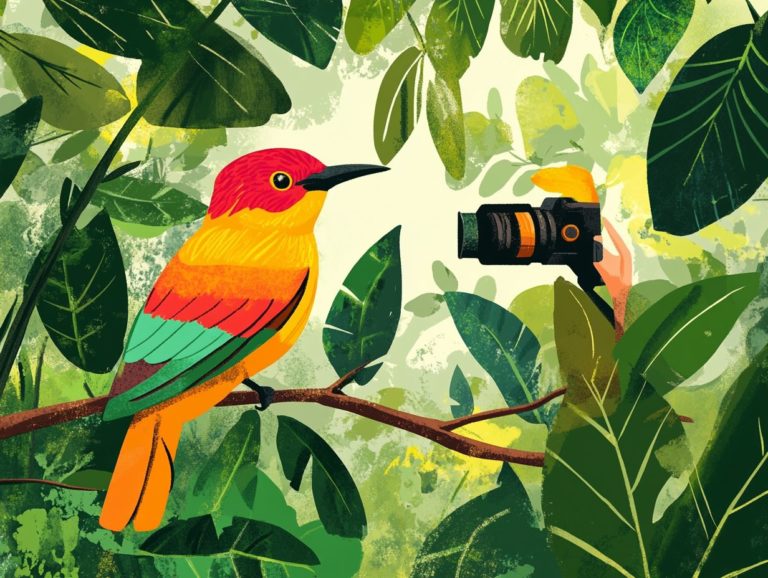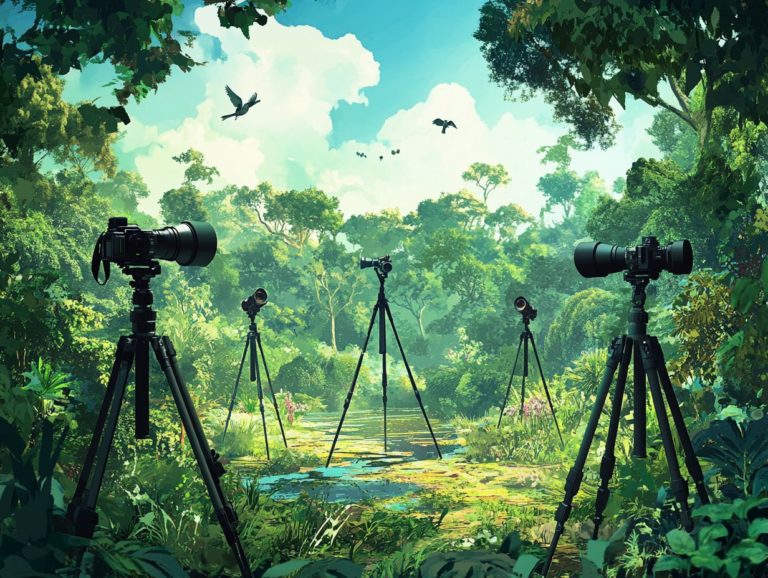High-Quality Binoculars for Bird Photography
Selecting the right binoculars for bird photography can truly elevate your birding experience in the field. Don’t miss out on the chance to enhance your birding experience!
Consider aspects such as magnification, lens size, image quality, and durability. Each plays a crucial role in finding that perfect pair.
This binoculars guide delves into essential features you’ll want to keep in mind, including close focusing distance, weatherproofing, and customer reviews.
Whether you’re a seasoned birdwatcher or just beginning your journey, grasping these key elements will empower you to make an informed choice and enhance your photography skills.
Get ready to explore binoculars that will help you capture stunning moments in the birding world!
Contents
- Key Takeaways:
- 1. Magnification and Lens Size
- 2. Image Quality and Clarity
- 3. Durability and Portability
- 4. Close Focusing Distance
- 5. Field of View
- 6. Image Stabilization
- 7. Weatherproofing
- 8. Eye Relief and Comfort
- 9. Brand and Price
- 10. Customer Reviews and Ratings
- What Makes a Good Binocular for Bird Photography?
- What Are the Different Types of Binoculars Available for Bird Photography?
- Is It Necessary to Invest in Expensive Binoculars for Bird Photography?
- How Can One Test the Quality of Binoculars for Bird Photography?
- What Are Some Recommended Brands for High-Quality Binoculars for Bird Photography?
- How Can One Properly Maintain and Care for Their Binoculars?
- Frequently Asked Questions
- What makes a pair of binoculars high-quality for bird photography?
- Do I need to spend a lot of money on high-quality binoculars for bird photography?
- What is the best magnification power for bird photography binoculars?
- Can I use any type of binoculars for bird photography?
- What should I look for when choosing high-quality binoculars for bird photography?
- Are there any additional accessories I should consider when purchasing high-quality binoculars for bird photography?
Key Takeaways:
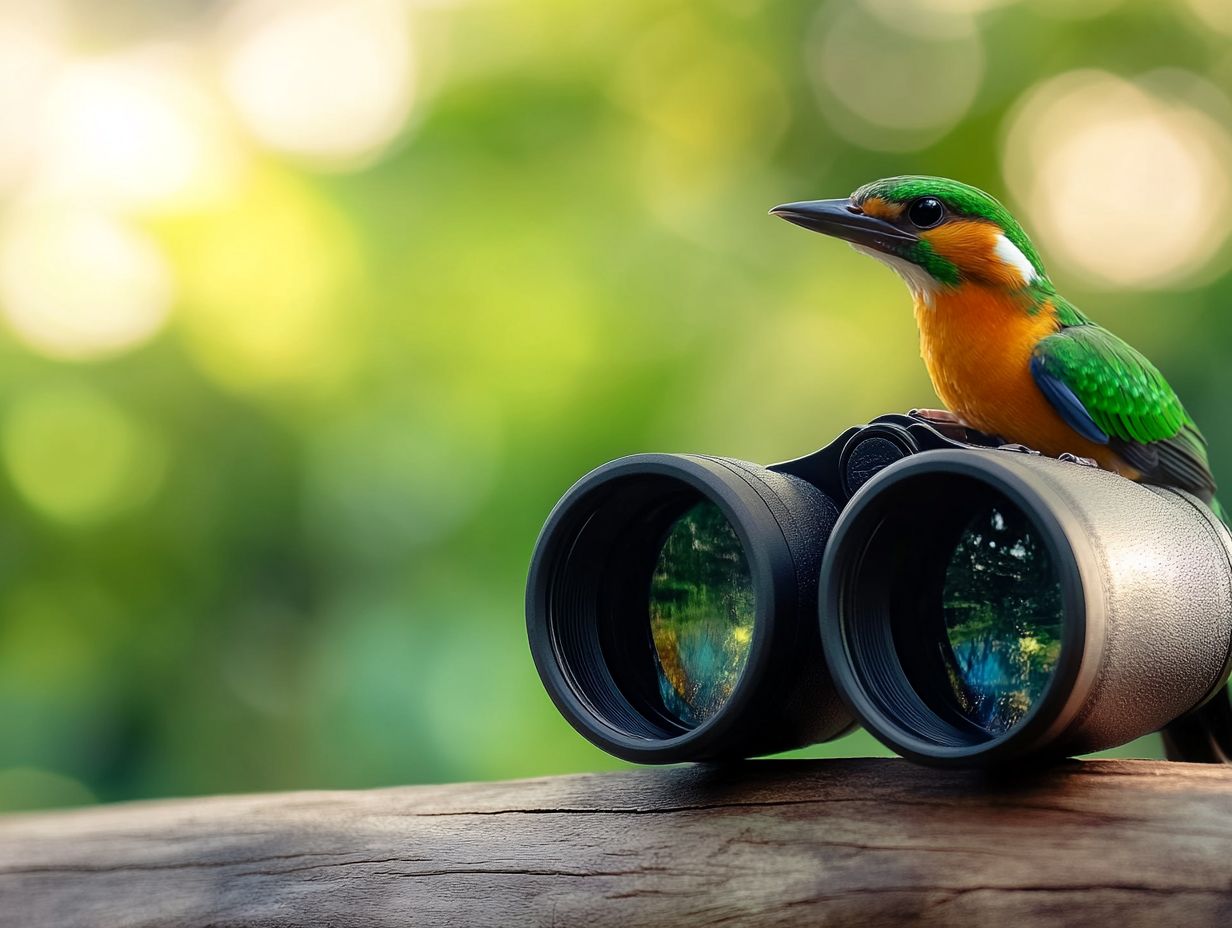
- Investing in binoculars with a high magnification and large lens size is essential for capturing quality bird photography and maximizing optical clarity.
- Image quality and visual clarity are crucial factors to consider when choosing binoculars for bird photography.
- Durability, portability, and a wide field of view are important for outdoor photography, along with a close focusing distance.
1. Magnification and Lens Size
Magnification and lens size are pivotal when choosing binoculars for birding. These factors influence optical performance and your viewing experience.
A higher magnification can enhance details in a bird s plumage. However, it often comes at the cost of a reduced field of view.
Consider a pair of Zeiss Victory binoculars with a 10x magnification. They provide remarkable detail, but offer a narrower field of view than an 8x model.
On the other hand, Swarovski’s EL series excels with excellent image stabilization and an expansive field of view, allowing you to follow flocks with effortless grace. Vortex binoculars, particularly the Viper series, strike a perfect balance. With their 8x magnification, they deliver clarity while maintaining a broader perspective, making them exceptional for spotting birds across diverse habitats.
2. Image Quality and Clarity
The quality and clarity of binoculars are crucial in elevating your birding experience. Features like high-definition optics, which enhance clarity and color, and advanced lens technology ensure superior color rendition and visual sharpness. Additionally, if you’re looking to capture those moments, knowing how to choose a camera for bird watching can further enhance your experience, regardless of the conditions you encounter.
This becomes especially clear when you compare models like the Leica Trinovid and Maven C.1. Both binoculars are celebrated for their optical excellence, but the Leica Trinovid often stands out with its unparalleled color fidelity, making each hue come alive in natural settings. Meanwhile, the Maven C.1 impresses with its sharpness, though it may not perform as well under certain lighting conditions.
Factors such as ambient light and atmospheric clarity can significantly affect how you perceive optical clarity, leading to variations in color and detail representation.
Your choice depends on your specific needs and the environments in which you plan to observe.
3. Durability and Portability
Durability and portability are critical factors for you as a birder. Lightweight binoculars that can endure various conditions allow you to comfortably explore diverse environments without worrying about compromising your equipment.
These binoculars are often crafted from high-grade materials like polycarbonate and magnesium alloys, which not only boost strength but also significantly lighten the load. Advanced lens coatings play a key role too, delivering exceptional optical clarity while keeping the bulk of traditional designs at bay.
If you spend long hours observing wildlife, a binocular harness can be a game changer. It distributes weight evenly across your body, alleviating any strain on your neck and shoulders. This thoughtful combination of materials and design elevates your birding experience, making it not just enjoyable, but truly sustainable.
4. Close Focusing Distance
Close focusing distance is an essential feature in binoculars for birdwatching. It allows you to observe nearby subjects with remarkable detail, significantly enhancing your overall optical experience during field outings.
This capability is vital when you’re on the hunt for elusive small bird species. You may also want to examine the delicate details of flowers up close. Different models on the market offer varying degrees of close focusing, which can dramatically impact your experience as a birder or nature enthusiast.
Take the Hawke Frontier binoculars, for example. They are renowned for their impressive close-focusing abilities, enabling you to appreciate the intricate details of a hummingbird’s feathers or the subtle shades of a wildflower.
Such features deepen your connection to nature and serve as valuable tools for both casual observers and seasoned birdwatchers, all striving for clarity and precision in their observations.
5. Field of View
The field of view is a crucial specification in binoculars. A wider field allows you to track fast-moving bird species with ease, enhancing your birding experience through effortless observation.
This measurement tells you how much of the landscape you can see at a certain distance, typically expressed in feet at 1,000 yards. A binocular with a generous field of view helps you spot elusive birds hidden in dense foliage. It also enables you to scan larger areas, making it invaluable in diverse birding environments.
For instance, when comparing models like the Zeiss SFL and Swarovski NL Pure, their respective field of view metrics cater to specific birdwatching scenarios. The Zeiss SFL provides a wider field, perfect for observing flocks of birds in flight. In contrast, the Swarovski NL Pure excels at delivering crisp details essential for identifying individual species.
Ultimately, the choice between these binoculars often boils down to your preferred style and the typical environments you explore.
6. Image Stabilization
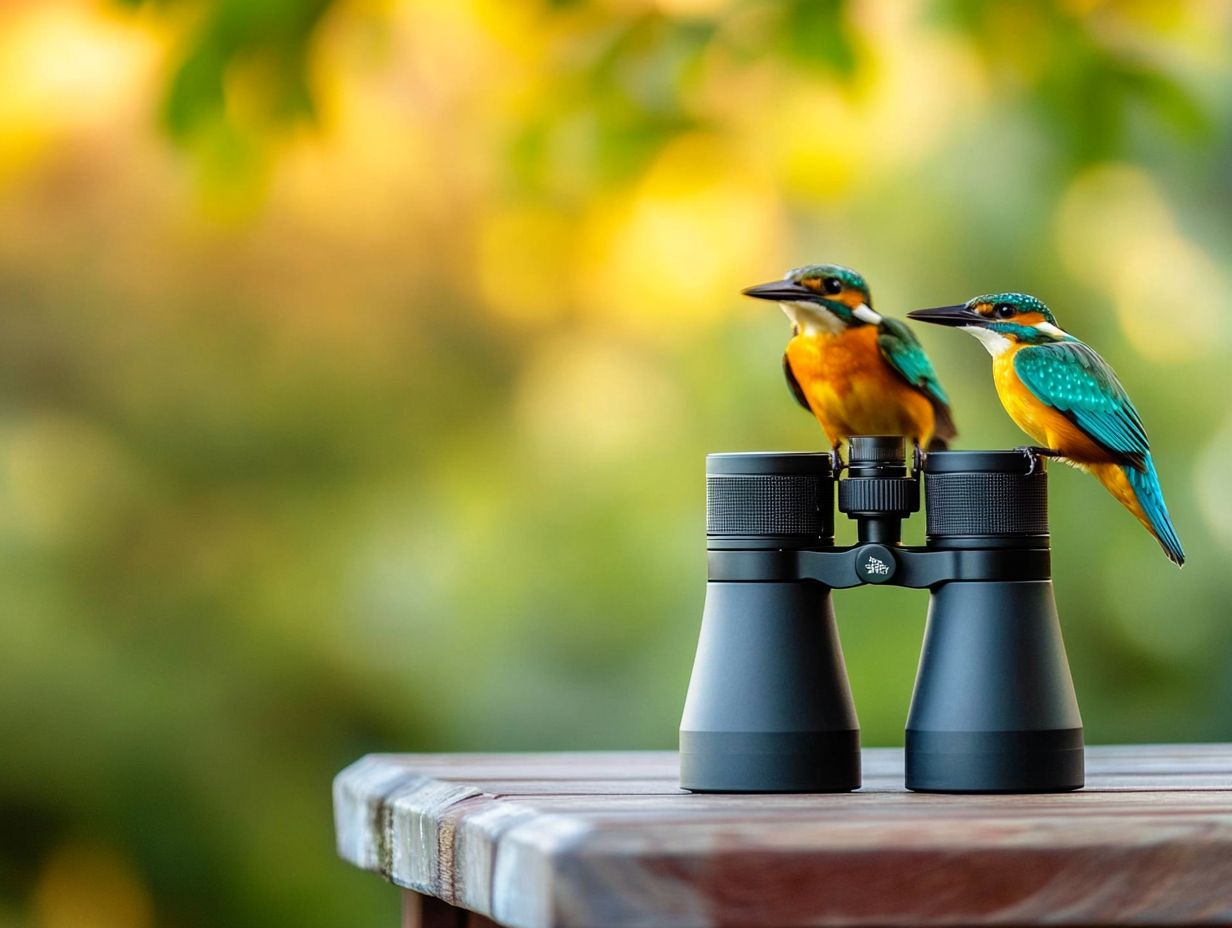
Image stabilization technology in binoculars significantly elevates your optical experience, especially in dynamic environments like during the Crane Festival. Maintaining a steady view is essential for effectively observing elusive feathered friends.
This technology minimizes blurring caused by hand movements. It allows you to focus intently on your subjects without the annoyance of jittery visuals. Leading brands have integrated this stabilization feature, using advanced systems that respond instantly to your movements. These brands utilize specialized lenses designed to counteract vibrations, making it easy to track fast-flying birds or spot secretive species tucked away in the foliage.
The outcome? A more enjoyable and productive observation experience during those long hours spent immersed in nature, enabling you to stay engaged without the discomfort of visual fatigue.
7. Weatherproofing
Weatherproofing is an essential feature in binoculars. It allows you to confidently use your equipment in various environmental conditions without sacrificing performance or optical clarity.
This capability to withstand the elements is a game-changer for enthusiasts like you. Whether caught in a sudden rainstorm or navigating swirling dust, you ll appreciate reliable performance.
Leading brands have introduced innovative designs and durable materials to enhance this vital characteristic. For example, high-quality rubber armor and O-ring sealing protect internal components from water and debris. Additionally, nitrogen purging effectively prevents fogging during drastic temperature shifts.
Rigorous testing under simulated conditions, like heavy rain or high humidity, allows manufacturers to showcase their products resilience. This way, you can focus solely on observing wildlife, free from concerns about how well your gear performs.
8. Eye Relief and Comfort
Eye relief is crucial for comfort while using binoculars. It helps prevent strain during long birdwatching sessions.
A generous eye relief alleviates squinting and discomfort, especially for those who wear glasses. Many popular binocular models feature ergonomic designs and adjustable eyecups, tailored for different needs.
When selecting binoculars, consider your individual requirements, such as your distance from the eyepiece and comfort preferences. Prioritizing a model with the ideal eye relief can significantly enhance your birdwatching experience.
9. Brand and Price
Choosing the right brand and understanding prices is essential for finding great binoculars. Events like the Audubon Convention can provide valuable insights.
In today s market, brands like Zeiss, Swarovski, Maven, and Vortex have carved out unique niches. Zeiss and Swarovski often represent premium quality, with prices justified by their exceptional performance and durability.
Maven and Vortex offer more budget-friendly options, allowing you to enjoy quality without breaking the bank. By examining reviews and ratings, you can navigate these choices effectively.
10. Customer Reviews and Ratings
Customer reviews guide you to the best binoculars for birding. They provide invaluable real-world insights into performance and user satisfaction.
By diving into feedback, you can discover recurring themes related to clarity and ease of use. Many users rave about the Nikon Monarch 5 for its remarkable light transmission and lightweight design.
The Vortex Diamondback is praised for its rugged construction and impressive warranty, giving you confidence in its reliability. These insights empower you to select the perfect model for your needs.
What Makes a Good Binocular for Bird Photography?
A good binocular for bird photography must have great optics and close focus. Additionally, understanding photography gear essentials for birdwatching can enhance your experience. Quality magnification allows you to see detailed feather patterns.
For photographing moving birds, image stabilization technology ensures clear and steady images. Specialized lens coatings reduce glare and improve light transmission, resulting in vibrant images.
Mechanical performance and ergonomics also matter; a well-designed binocular enables swift adjustments and comfortable handling, allowing you to seize fleeting moments effortlessly.
Explore your options today and find the perfect pair to enhance your birdwatching experience!
What Are the Different Types of Binoculars Available for Bird Photography?
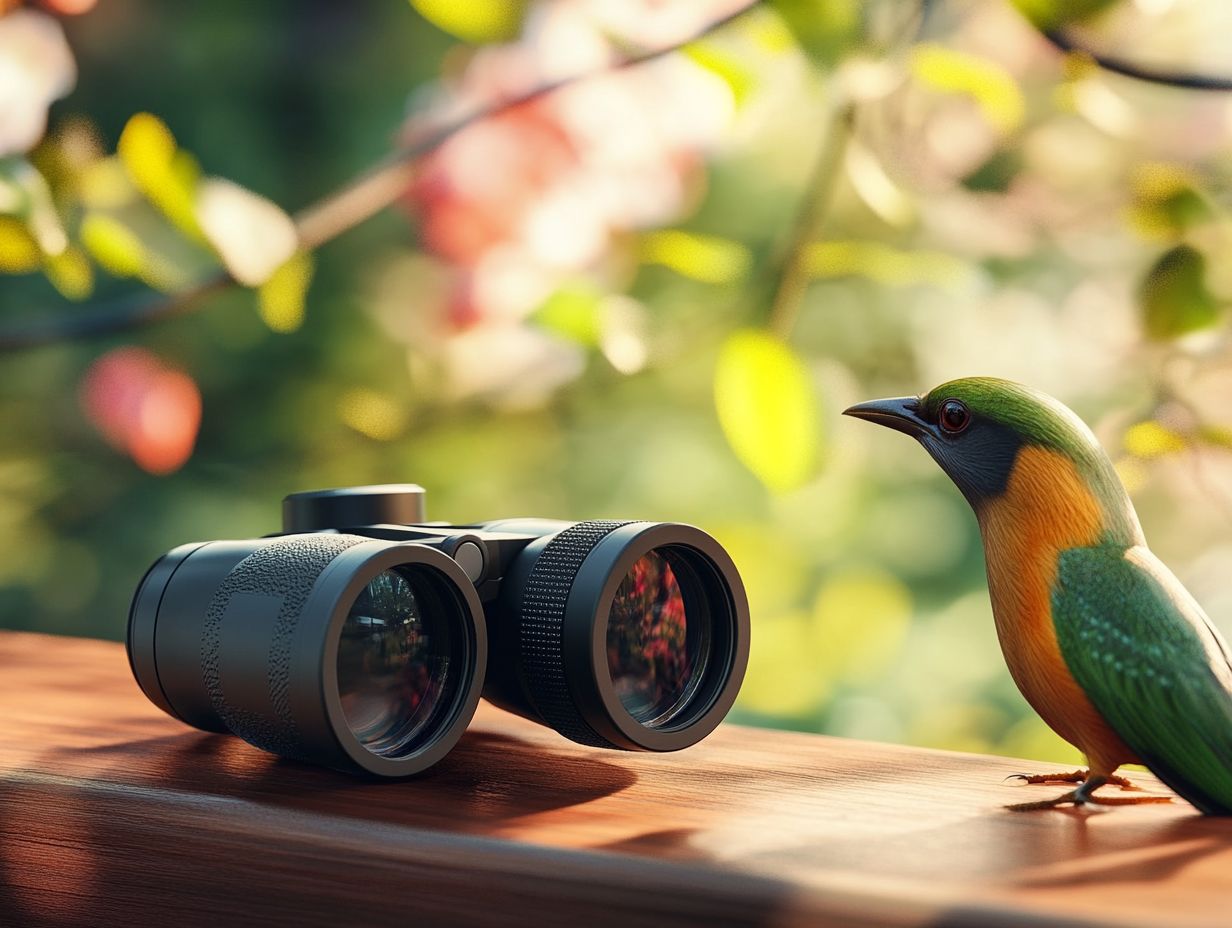
When choosing binoculars for bird photography, you’ll find a range of options tailored to different needs and budgets. For the best experience, consider the best binoculars for backyard bird watching, as it’s crucial to choose wisely based on your specific requirements.
If you’re just starting out or prefer something lightweight for hiking, consider binoculars that offer a convenient solution without sacrificing too much image quality.
For those in the mid-range, full-size models provide a more robust viewing experience. They deliver brighter and clearer images while remaining portable enough for your excursions.
At the higher end, premium binoculars feature top-notch lenses that ensure exceptional clarity and brightness. However, they often come with a price tag that reflects their superior quality.
By understanding these distinctions, you can better determine which binoculars suit your style whether you’re into casual landscape shooting, birdwatching, or serious wildlife photography.
Is It Necessary to Invest in Expensive Binoculars for Bird Photography?
Many bird photographers wonder if high-end binoculars are worth the investment. While premium models can indeed provide exceptional optical clarity and performance, the best binoculars for bird watching on a budget might still offer the quality you need.
Take brands like Swarovski and Leica, for example. They are celebrated for their top-tier optics and special coatings that enhance brightness and color reproduction. These features make them perfect for capturing breathtaking images in various lighting conditions.
On the other hand, Nikon and Vortex offer budget-friendly options that still get the job done, delivering satisfactory performance with solid resolution and a durable build just right for casual birdwatching trips.
Ultimately, the choice boils down to how often you plan to use high-performance binoculars and what specific features you might need. Consider options like waterproofing, which keeps your binoculars safe in wet conditions, or image stabilization, which helps reduce shaking for clearer views. These factors could very well justify a higher price tag. Don t miss out on capturing stunning images your choice in binoculars can make all the difference!
How Can One Test the Quality of Binoculars for Bird Photography?
Testing the quality of binoculars for bird photography requires evaluating key factors: optical performance, ease of use, and adaptability to various lighting conditions. For a detailed understanding of selecting the right equipment, refer to how to choose binoculars for long-distance birding. This assessment will guide you toward the best choice tailored to your needs.
To truly grasp how well a pair of binoculars performs, compare them side by side in different environments, like under the bright light of day and the subtle hues of twilight. This approach will reveal differences in clarity and color accuracy, showing how effectively each model handles glare.
Pay close attention to features such as field of view and close focus capabilities; these will provide valuable insight into how adeptly these tools can capture both distant vistas and intricate details.
Engaging in hands-on experience is vital holding and maneuvering the binoculars allows you to assess comfort and functionality. This ensures that you can seamlessly track moving targets without any strain.
What Are Some Recommended Brands for High-Quality Binoculars for Bird Photography?
When you’re on the hunt for high-quality binoculars for bird photography, several brands rise above the rest. Zeiss, Swarovski, and Leica are synonymous with excellence, offering models that cater to the discerning eye of serious photographers. For detailed insights, check out these tips for choosing binoculars for bird photography.
These brands present a variety of options tailored for capturing the beauty of avian life. The Zeiss Victory SF series is renowned for its outstanding brightness and expansive field of view. For those interested in evening birdwatching, consider the best binoculars for twilight bird watching; it’s easy to track elusive birds across different lighting conditions with these binoculars.
Swarovski’s EL Range features technology that reduces shake, helping you achieve clearer pictures. Then there’s Leica s Noctivid, which excels in low-light performance, ensuring you don t miss any details, even as dusk settles in.
Each of these models enjoys stellar user ratings and reviews that underscore their reliability and performance. Although their price points reflect premium craftsmanship, they are a worthy investment for anyone serious about bird watching and photography.
How Can One Properly Maintain and Care for Their Binoculars?
Proper maintenance and care of your binoculars are essential for ensuring their longevity and optimal performance. Routine cleaning and safe storage will significantly extend the life of these critical tools.
To achieve this, use gentle methods that respect the delicate lens coatings. Start with a soft, lint-free microfiber cloth to wipe away dust or fingerprints. For stubborn smudges, a diluted solution of distilled water with a few drops of mild dish soap works wonders just don t soak the cloth.
Regularly check the alignment and focus adjustments to maintain mechanical performance. Store your binoculars in a dedicated case to protect them from humidity and temperature changes.
Frequently Asked Questions
What makes a pair of binoculars high-quality for bird photography?
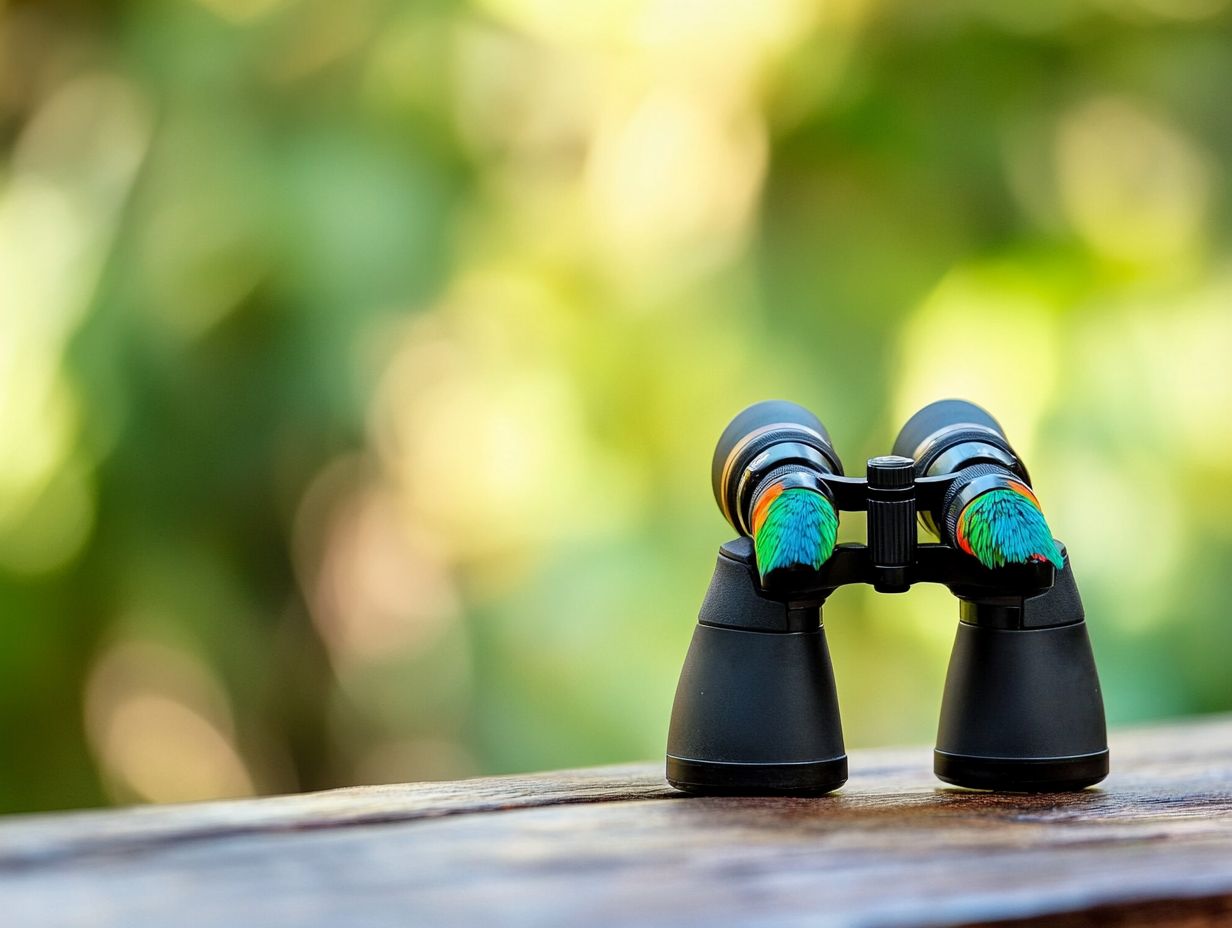
High-quality binoculars for bird photography should have:
- High magnification power
- Sharp, clear optics
- Wide field of view
- Durability and weather resistance
Do I need to spend a lot of money on high-quality binoculars for bird photography?
Not necessarily! While premium options are available, budget-friendly choices can still deliver good quality. It ultimately depends on your specific needs and preferences.
What is the best magnification power for bird photography binoculars?
A magnification power of 8x or 10x is generally recommended. This allows you to get a close-up view of the birds while maintaining a wide enough field of view to track their movements.
Can I use any type of binoculars for bird photography?
You can technically use any binoculars, but it’s best to choose ones designed for bird photography. For the best results, consider the must-have accessories for bird photography, which include features like image stabilization and close focus ability—important for capturing clear and detailed photos.
What should I look for when choosing high-quality binoculars for bird photography?
In addition to magnification power and optics quality, consider:
- Weight and size for ease of use
- Close focus ability
- Waterproof and fog-proof capabilities
Are there any additional accessories I should consider when purchasing high-quality binoculars for bird photography?
Some helpful accessories include:
- A tripod or monopod for stability
- A harness or strap for comfortable carrying
- A lens cleaning kit to keep your optics in top condition
- A tripod adapter for attaching binoculars to a camera or smartphone for digiscoping
Don t miss out on capturing stunning bird photos! Explore and find your perfect pair of binoculars today.

